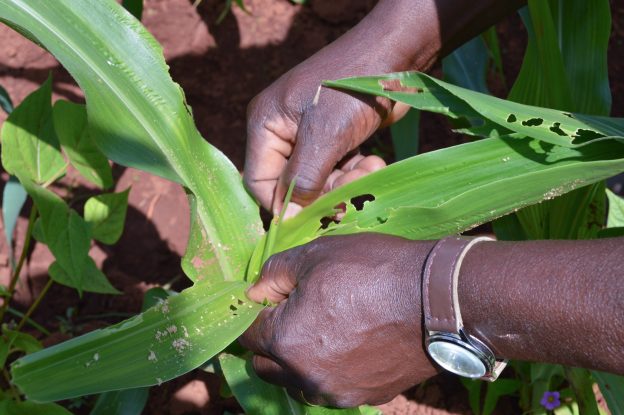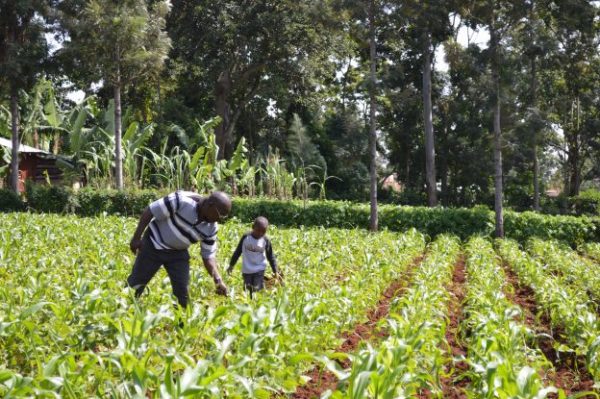Wycliffe Ngoda, 65, and his grandson inspect their maize crop for Fall Armyworm at his farm in Mbale, Kenya.
“I thank God I have a small family and none of them are going to school, otherwise it would have been a total disaster,” said Wycliffe Ngoda, 65, from Mbale, Vihiga county in Kenya. Ngoda farms two acres of maize in Kenya and in 2017, lost 50 percent of his crop to one of the most destructive crop pests in the world.
Globally, farmers lose 30-40 percent of their crops due to pests and diseases, according to the UN Food and Agricultural Organization.
To produce a good yield of a high quality, producers must protect their crop against insects, diseases and weeds. Small grain diseases affect production by reducing the yield and impairing the quality. To maximize profits, producers need to understand the influences that diseases may have on the crop potential. A single fungal pathogen may attack a range of small grains, while other small grain pathogens may be confined only to infecting a specific host. Additionally, cultivars may vary in their susceptibility to different diseases.
Like all agricultural innovations, crop protection products have evolved tremendously since their inception. From natural chemical elements to plant- and metal-based insecticides to synthetic products, formulations have drastically changed and for the better: today’s products are more sustainable, targeted, efficient and environmentally friendly than their predecessors.
When it comes to chemical intervention, there are three main categories:
- Herbicides: These kill or stop the growth of unwanted weeds. Worldwide, farmers have to contend with more than 30,000 species of weeds which fight with food crops for space, water and soil nutrients.
- Insecticides: These kill insects and mites, such as these Bug Thugs. More than 10,000 species of plant-eating insects and 3,000 species of roundworms can attack farmers’ crops around the world leaving food damaged and inedible.
- Fungicides: These destroy or prevent the growth of disease-causing fungi. There are more than 50,000 diseases that get inside crops and poison or kill plant cells.
Fall Armyworm
Native to the tropical and subtropical regions of the Americas, the invasive Fall Armyworm (FAW) has made its way through Africa and has most recently been identified in India and other parts of Asia. FAW targets more than 80 different plants including rice, cotton, wheat and soybeans. It has been particularly devastating in the maize producing regions, according to the Centre for Agriculture and Bioscience International (CABI), Fall Armyworm destroys 21 – 53 percent of the African maize crop each year. This pest has the potential to put hundreds of millions of people at risk for hunger and cause billions more dollars in damage.

The pest was first detected on the African continent in Nigeria in January 2016 and has quickly spread to 44 countries across sub-Saharan Africa. In 2018, the pest arrived in India and the FAO warned it could threaten the food security and livelihoods of millions of small-scale farmers in Asia. In 2019, the pest spread to Southeast Asia and China as well as South Korea and the Philippines. The pest has arrived in Egypt, bordering the Mediterranean, and so it is likely that the pest could also spread to Europe.
The effective management of Fall Armyworm can be achieved through integrated pest management (IPM)—a system of managing pests which is designed to be sustainable. IPM involves using the best combination of cultural, biological and chemical measures, including plant biotechnology and pesticides as appropriate. In the case of FAW, plant biotechnology has been used to successfully and sustainably manage the pest in North and South America, and early evidence suggests it is also effective in South Africa—the only place on the continent where farmers have access to corn varieties resistant to the pest.
A sound IPM strategy for this pest should include effective scouting for FAW and preventative measures to stop any infestation. Where an economic threshold is reached, farmers like Ngoda must be given access to effective tools to prevent the destruction of their crop, as outlined in the US Agency for International Development (USAID) guide for IPM in Africa. For successful IPM intervention, the tools available to farmers should include a variety of insecticides, plant biotechnology and other pest management tools as necessary to not only quell the pest, but to prevent resistance to control measures.
Clear, evidence-based advice to farmers is another necessary cornerstone of an effective management strategy. Because FAW is an invasive species, farmers require tailored innovative solutions on crop protection that are evidence-based and scalable. Farmers also need clear and consistent advice. They should be made aware of the danger of the pest, taught to recognize it, and informed of its ecology and lifecycle, including when it is most vulnerable to pest management options.
Many of those options require a functional regulatory environment that gives farmers access to technology and a choice of tools to protect their crop from FAW, while also protecting human and environmental health, and balancing risks and benefits.
Finally, coordination of all stakeholders involved in managing FAW with a focus on solution-oriented dialogues will ultimately serve as the link to bring together all elements of an effective management strategy. FAW management should entail multi- stakeholder engagement with farmers, governments, service provides, NGOs and the private sector with a collective goal of protecting farmer livelihoods and ensuring food security globally, but especially in vulnerable regions of Africa.









